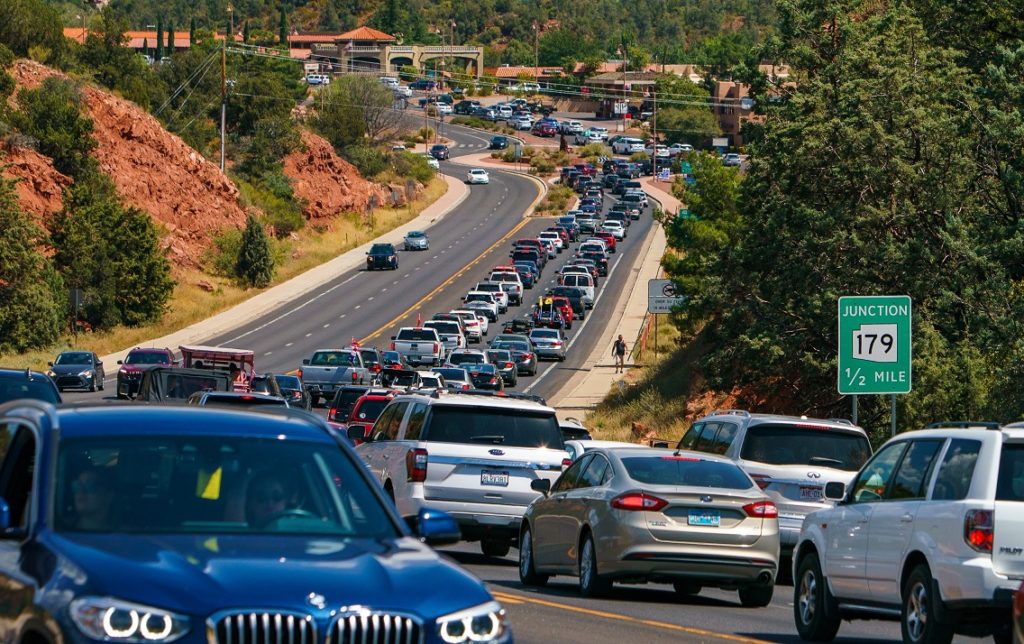Every year we must deal with the murderbots. It’s not a big deal for most long-term residents.
They come every spring, randomly vaporizing two residents a day for 90 days with their disintegrator ray guns. The deaths appear to be quick and painless, but, yes, they’re still instant deaths. You never know if you might be next, but statistically, it probably won’t be you.
When the murderbots first came to Sedona some 25 years ago they would vaporize one person a week. It was horrific; residents were terrified and unwilling to leave their homes. After a few years, the death toll rose to two a day.
Residents took up arms. We held meetings. Hosted forums. Meet in neighborhood groups. Wrote letters and protested. We begged Sedona City Council to end the rampage, but the council declined.
“No,” they said. “It won’t be that bad.”
Then the murderbot deaths leveled off. Two a day for 90 days. 180 people a year. In a town of 9,600, that’s not so bad. Statistically, anyway. Subsequent councils have also declined to act, in deference to the decisions of previous councils.
“That’s the cost of living in Sedona,” council members say at meetings when people complain. Something must be done to thin the herd, reduce traffic on our trails and roads, cut down on the number of people making reservations at restaurants, or those in line at pharmacies, thrift stores, day spas and art galleries.
The murderbots are just a thing now. We old-timers are used to it. They atomize 180 folks a year in the spring and we accept it.
“Sure, it sucks, but that’s just life in Sedona,” we say. “Enjoy the views while you wait to be vaporized.”
Newcomers and new council members who have no point of reference to a life with murderbots are shocked, but we tell them to get used to it. Nothing can be done. It’s not like we could just press the murderbots’ “off” buttons early, before they meet their murder quota.

The allegory of the murderbots is as ridiculous and absurd as the claims of Sedona residents who argue that nothing can be done to repair our traffic congestion on eastbound State Route 89A wrapping around Cook’s Hill or coming north on State Route 179 from the Village of Oak Creek.
Just as murderbots were created by the hand of man, so are our roads. They are designed by humans, paved by humans and driven on by human drivers. Traffic is a human problem; ergo, it can be mitigated by humans. We can theorize ways to improve traffic flow throughout our city. It’s not that hard.
When we wanted to get from the canyon floor to the top of the Mogollon Rim, early pioneers didn’t say it was impossible. Instead, they built the switchbacks. When residents wanted to cross Wilson Canyon, they didn’t say it was impossible; instead, Franklin D. Roosevelt’s Civilian Conservation Corps built Midgley Bridge.

We widened State Route 89 from Cottonwood to Sedona from two lanes to four, widened a portion of State Route 79 from Sedona to the Village of Oak Creek from two lanes to four and built no fewer than seven bridges over Oak Creek in the Sedona area.
Traffic problems are not like high tides or volcanos or an annually flooding river. We couldn’t mitigate those, yet we sacrificed animals to Poseidon, Hephaestus and Hapi anyway. We don’t have a traffic god analogue — can we pray to … Asphaltus?

Working under our own power, or in cooperation with the Arizona Department of Transportation, Coconino County, Yavapai County, the state of Arizona and even the U.S. Department of Transportation, we can make the kind of traffic improvements we need to alleviate this pressure.
We flatten things and raise things to build what’s needed. There are scores of things we can do to take pressure off the Cook’s Hill stretch and State Route 179 and provide alternate routes from Uptown to West Sedona to the Chapel area.
If the murderbots can be turned off by a switch, traffic problems can be fixed political will and community pressure.



















